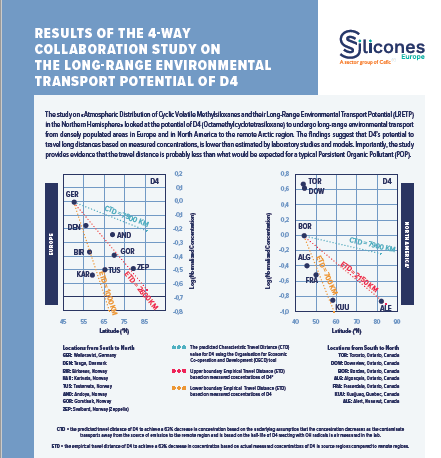RESULTS OF THE 4-WAY COLLABORATION STUDY ON THE LONG-RANGE ENVIRONMENTAL TRANSPORT POTENTIAL OF D4
The study on «Atmospheric Distribution of Cyclic Volatile Methylsiloxanes and their Long-Range Environmental Transport Potential (LRETP) in the Northern Hemisphere» looked at the potential of D4 (Octamethylcyclotetrasiloxane) to undergo long-range environmental transport from densely populated areas in Europe and in North America to the remote Arctic region. The findings suggest that D4’s potential to travel long distances based on measured concentrations, is lower than estimated by laboratory studies and models. Importantly, the study provides evidence that the travel distance is probably less than what would be expected for a typical Persistent Organic Pollutant (POP).
EMPIRICAL TRAVEL DISTANCE MUCH SHORTER THAN PREDICTED CTD
The decrease in measured concentrations – as visualised by the green area on each map – shows empirical travel distances (ETD) for D4 that are below the predicted critical travel distance (CTD) (7900 km) based on theoretical modelling. This is particularly relevant as it indicates that D4’s empirical travel distance (ETD) would fall below the benchmark CTD of 2000 km. 2
These findings suggest the actual long-range environmental transport (LRETP) – as indicated by empirical travel distances – is smaller than the predicted LRETP (as indicated by characteristic travel distance) based on laboratory-measured half-lives of airborne cVMS. Further steps are being put in place for the research collaborators to better understand atmospheric conditions and processes that may affect the atmospheric transport, degradation rates as well as other potential degradation mechanisms of D4.
ABOUT THE STUDY
The Norwegian Institute for Air Research (NILU), Stockholm University and the University of Toronto launched a 4-way research collaboration alongside the Silicone industry. This research collaboration on «Atmospheric Distribution of Cyclic Volatile Methylsiloxanes (and other cVMS) and long-range transport potential in the Northern Hemisphere» aims at understanding actual travel distance and LRETP of D4 in air.
Click here to access the full infographic.

News